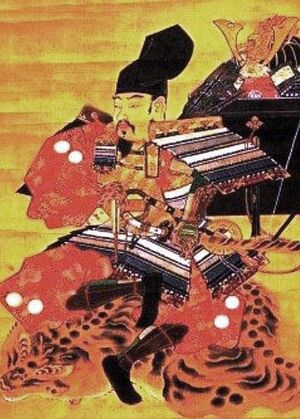Nitta Yoshisada facts for kids
Nitta Yoshisada (新田 義貞, 1301 – August 17, 1338) was a brave samurai leader in Japan. He was also known as Minamoto no Yoshisada. Nitta Yoshisada lived during a time called the Nanboku-chō period. This was a period when Japan had two emperors.
Yoshisada was the head of the Nitta clan. He supported the Southern Court and Emperor Go-Daigo. He is famous for leading his army to attack Kamakura. In 1333, he captured Kamakura from the Hōjō clan. Later, he fought against the Ashikaga brothers. He died in battle in 1338.
Contents
Early Life of Nitta Yoshisada
Nitta Yoshisada was born in 1301. He was the oldest son of Nitta Tomouji. In 1317, he became the leader of the Nitta family. He also took control of Nitta Manor in Kōzuke Province. Yoshisada married a noblewoman named Kōtō-Naishi. The emperor helped arrange their marriage.
Kamakura Campaign
Nitta Yoshisada and Ashikaga Takauji were often rivals. Some people say their rivalry caused a big split in Japan. This split led to the Northern and Southern Courts. Yoshisada fought for Emperor Go-Daigo against the Ashikaga clan. The Ashikaga family was ranked higher than the Nitta family. This was even though they came from a younger ancestor. The Nitta family did not fight in the Genpei War. Because of this, they never gained much power in Kamakura.
March on Kamakura
In 1331, the government ordered Nitta to join an army. But Prince Morinaga and Emperor Go-Daigo told him to attack the Hōjō clan instead. So, Nitta left his post. He went back to his home province of Kozuke. There, he gathered other family members and loyal followers. His brother Nitta Yoshisuke also joined him. They began to march towards Kamakura.
Nitta's army won some early battles. They defeated the Hōjō defenders. Then, they chased them towards the city.

Kamakura was hard to attack by land. It was surrounded by steep hills. Nitta first tried to enter through the Gokurakuji Pass. He also tried the Kewaizaka Pass. But the Hōjō forces were too strong. Nitta decided to try attacking by sea. He planned to go around Inamuragasaki Cape. This cape was on Sagami Bay, west of Kamakura.
Nitta waited for low tide. Then, he moved his soldiers through the beaches to the south. A famous story says he threw his sword into the ocean. He prayed to Ryūjin, a sea-god. The story says the waters then moved apart for him. This allowed his army to pass.
A stone monument at Sode no Ura tells this story. It says:
666 years ago on May 21, 1333 Nitta Yoshisada, judging an invasion on land to be difficult, decided to try to bypass this cape. This is the place where, according to tradition, he threw his golden sword into the waves, praying the sea-god to withdraw them and let him pass. (Erected in 1917)
Fall of Kamakura
Nitta's army successfully took the city. The power of the Hōjō clan was completely broken. After Kamakura fell, Emperor Go-Daigo gave out the Hōjō lands. Yoshisada was made governor of Echigo Province. He also became vice-governor of Harima Province and Kōzuke Province. He received two important swords: Higekiri and Onimaru Kunitsuna.
Later Campaigns
In the next few years, Nitta Yoshisada's rivalry with Ashikaga Takauji grew. The emperor ordered Yoshisada to defeat Takauji and his brother Ashikaga Tadayoshi. The two armies fought many battles. Yoshisada's forces were eventually defeated. The Ashikaga brothers then marched towards Kyoto.
The Ashikagas captured Kyoto for a few days in February 1336. But then help arrived for Yoshisada. Prince Norinaga and Prince Takanaga sent aid. In April 1336, Nitta attacked Akamatsu Norimura. He kept fighting until June. Then, he had to retreat when Tadayoshi's army advanced. Yoshisada was defeated in the Battle of Minatogawa. This allowed Takauji to take Kyoto again.
Nitta retreated with the emperor to Hieizan. On November 13, 1336, the emperor agreed to return to Kyoto. Before he left, he asked Nitta to escort Prince Takanaga and Prince Tsunenaga. They went to Echizen Province. They reached a loyalist castle. There, they had to face the siege of Kanegasaki (1337). Nitta managed to escape. But his son Nitta Yoshiaki and the two princes were killed.
Death
Nitta's death was as memorable as his life. He was fighting in the siege of Kuromaru. His enemy was Hosokawa Akiuji, an ally of Takauji. During the battle, Nitta's horse was hit by arrows and fell. Nitta was trapped under his dead horse. He could not move. This made him an easy target for archers.
As a final act, Nitta is said to have pulled out his short sword. He then cut off his own head. Many of his fellow samurai also took their own lives nearby. This was a sign of their loyalty to him. Nitta Yoshisada died on August 17, 1338.
Honours
- Senior First Rank (August 7, 1882; given after his death)
See also
- Fujishima Shrine
- Nitta Yoshiaki - son of Yoshisada
- Nitta Yoshioki - son of Yoshisada
- Nitta Yoshimune - son of Yoshisada
- Wakiya Yoshisuke - brother of Yoshisada, and founder of a branch family of Nitta, called Wakiya



